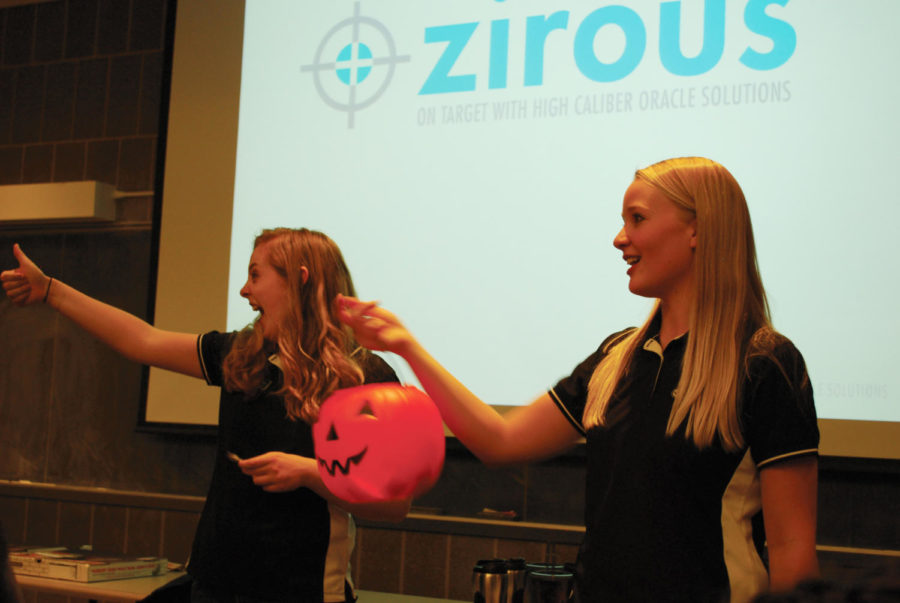Programs push for women in science, engineering
October 22, 2012
Engineering may be commonly viewed as a male-dominated field, but there are plenty of women at Iowa State who would argue that engineering is not purely a male monopoly.
Kelsey Bruning, president, and Cara Petrie, president-elect, are the leaders of the Iowa State chapter of the Society of Women in Engineering. These two have long had a knack for math and science, a skill set representative of most engineers.
Bruning and Petrie are aware they are not the only girls who have taken a liking to these science-oriented subjects. As a result, they have set out to spearhead the goals of the Society of Women in Engineering: to serve as a source of outreach to young girls at the K-12 level, as well as making female engineers already at Iowa State more comfortable and to aid in their professional development.
“We have a company from industry come every time and they give a professional development topic as well as talk about the opportunities within their company,” Petrie said regarding how the Society of Women in Engineering serves in professional development.
Examples of the society’s aid in professional development include “interviewing; [understanding] differences between an internship and a co-op; and teamwork and the importance of it in engineering.”
“We try to just make it a really welcoming environment,” Bruning said. “We try to encourage friendships as well as doing professional development so we’re prepared when we leave college but we also have a support network.”
Even with resources aplenty at Iowa State, the problem results in reeling in prospective students. Lora-Leigh Chrystal, on-campus coordinator with Women in Science and Engineering, emphasizes how they go about fostering interest in science and engineering.
“Half of our program is K-12 outreach,” Chrystal said. “We have about 1,500 girls on campus in the fall for the Road Less Travelled Conference. This conference allows girls in grades 6-12 to participate in activities such as career exploration, tours and workshops.”
While Chrystal works on encouraging more girls to be interested in science and engineering, the purpose of Women in Science and Engineering is also to get men interested.
“To supplement, we also have students go out to classrooms all over the state of Iowa to interact with both boys and girls, getting them interested in science and math,” Chrystal said. “[By the end of the year,] 13,000 kids will have been involved in some of our outreach programs.”
The Society of Women in Engineering does not shy away from engaging with the future of female engineers, either. Petrie represents one way they engage the Iowan female youth.
“One of the big events we do every year is GLEE [Girls Learning and Experiencing Engineering] day,” Petrie said. “We have a fall and a spring day for grade school and middle school girls as well as high school girls. We do fun ‘science-y’ type engineering activities with them.”
Although female enrollment in the College of Engineering has been fairly level, hovering at about 15 to 20 percent within the past decade, retention for the current 14.1 percent has not been much of an issue. Chrystal called retention for female science, technology, engineering and math majors “almost perfect.”
Women in Science and Engineering contributes to this successful retention rate in large part to the learning communities they offer. Around 260 female students participate in these communities, which serve as a solid foundation for girls who may feel a sense of isolation in what are largely male-dominated fields of study and to form lasting relationships with like-minded peers.
“[Another supplementary resource includes] tutoring for our students that are participating in programs, so women in the College of Engineering, for example, can get free tutoring through our office that’s funded by the College of Engineering,” Chrystal said.
Increasing the percentage of women engineers at Iowa State often lies in outreach programs to acclimate young women with engineering and to display the quality education and resources the College of Engineering has to offer.
Although Bruning mentions how many people have told her “You probably shouldn’t do that,” or “I don’t think you’ll succeed in that,” she, as well as the Society of Women in Engineering, Women in Science and Engineering, and several other congruent programs and organizations at Iowa State, are prepared to overcome these social obstacles and to instill the passion they hold for engineering with others.







